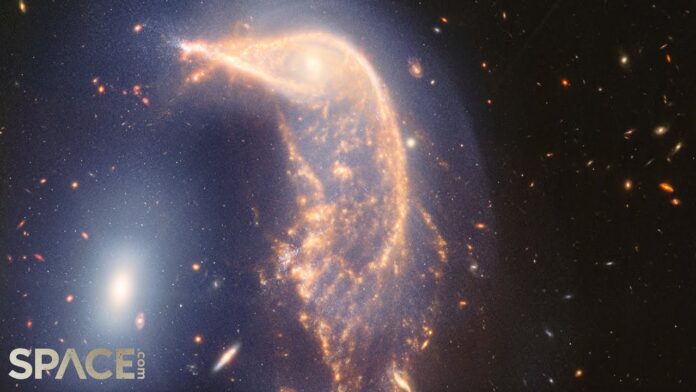To celebrate its second anniversary, the JWST reveals a breathtaking view of the Penguin and Egg galaxies as they drift toward inevitable merger
In a captivating display of cosmic artistry, the James Webb Space Telescope (JWST) has unveiled an extraordinary image of the Penguin and Egg galaxies, known collectively as Arp 142. Located approximately 325 million light-years away in the constellation Hydra, this remarkable duo has been slowly colliding for tens of millions of years.
Released on July 12, 2024, coinciding with the second anniversary of the JWST’s first image, this stunning photograph highlights the intricate interplay between the two galaxies. The larger of the pair, NGC 2936, affectionately dubbed the “Penguin,” exhibits a warped shape, a result of gravitational interactions with its smaller companion, NGC 2937, the “Egg.” This gravitational friction has altered the Penguin’s structure over the past 25 million years, leading to a dramatic transformation that will eventually culminate in a complete merger.
Originally a spiral galaxy akin to our Milky Way, the Penguin has undergone significant changes due to its close encounter with the Egg. As the Egg orbits at about 100,000 light-years away, the Penguin’s once-symmetrical spiral arms have stretched into forms resembling a beak and tail. Regions of gas and dust in these thinner areas have clumped together, igniting the birth of new stars.
The smaller Egg galaxy, glowing brightly to the Penguin’s left, remains relatively unchanged during this lengthy galactic dance. Despite its smaller appearance, both galaxies likely contain similar masses, which explains why the Egg hasn’t been consumed by its larger counterpart yet. Scientists estimate that the final merger between the Penguin and Egg is still millions of years in the future.
The stunning image is a product of data from JWST’s Near Infrared Camera and Mid-Infrared Instrument, capturing light that typically eludes the human eye. This capability has allowed the telescope to unveil some of the universe’s oldest and most distant structures, significantly enhancing our understanding of cosmic origins.
Mark Clampin, director of the Astrophysics Division at NASA Headquarters, commented on the significance of JWST’s achievements, stating, “In just two years, Webb has transformed our view of the universe. It has never been more possible to explore every facet of the universe.”
Analysis
Political
The discoveries made by the JWST reflect ongoing investment in scientific research and technology. As nations compete for advancements in space exploration, this milestone serves as a reminder of the importance of funding and supporting scientific endeavours that yield significant insights into our universe. The collaboration between various space agencies underscores the global nature of modern scientific inquiry.
Social
The public’s fascination with space and the cosmos has grown significantly, thanks in part to images like the one captured by JWST. This renewed interest in astronomy and science encourages educational initiatives and outreach programs aimed at inspiring future generations to pursue careers in STEM fields. The emotional resonance of such cosmic images plays a vital role in fostering a sense of community and shared curiosity about our place in the universe.
Racial
The representation of diverse scientists and researchers in space exploration is crucial for fostering an inclusive scientific community. The JWST team consists of individuals from various racial and ethnic backgrounds, highlighting the importance of diversity in scientific innovation. Encouraging underrepresented groups to engage in STEM can lead to a more comprehensive understanding of the universe and its mysteries.
Gender
Gender dynamics in space science continue to evolve, with an increasing number of women leading groundbreaking research initiatives. The visibility of female scientists within projects like JWST serves to inspire young women and girls to pursue careers in science and technology. Promoting gender equality in STEM fields remains essential for fostering diverse perspectives and ideas.
Economic
The advancements brought forth by the JWST have substantial economic implications, particularly in the aerospace and technology sectors. Investment in space exploration generates jobs and stimulates economic growth, showcasing the tangible benefits of scientific research. The findings from JWST may lead to new technologies and innovations that can be applied beyond astronomy, further emphasizing the interconnectedness of science and the economy.
